Fuji had in the past always excellent sensors in their digital SLRs but the Nikon bodies they used were alsways derived from lower end Nikon bodies. This hardly ever excited us about the Fuji SLRs. We are really not that demanding about the camera functionality but a body has to feel right. Now with the new Finepix S5 Pro finally Fuji uses a very good body: the body is essentially a Nikon D200 body. This way we don't need to review the body itself because the in our Nikon D200 review we were full of praise about the D200 body. This is one of the finest digital SLR bodies we ever used. Not as heavy as the Nikon D2x or Canon 1Ds Mk. II but still with a solid feel.
The main difference we have to deal with is the camera sensor, the electronics and the menu structure.
The sensor
In some way Fuji is the only sensor manufacturer who puts image quality higher than pixel count. Ok, all the other manufacturers also try to improve the ISO performance but only Fuji created a sensor design that captures a higher dynamic range. This nominal 6.1 MP sensor has a split pixel at each pixel location. The larger part is called S-pixel and is responsible for the normal image capture (lower highlights to shadows). Then there is a less sensitive and smaller R-pixel that captures extended highlight data. At the time you take a picture actually two images are created: one with the S-pixels and one with the R-pixels. Later in camera or in the RAW converter these two images get blended together.
The resolution is kind of in between 6MP and 12MP because the special honeycomb layout allows better upsizing compared to other pure 6MP sensors. We use in this review the 12MP interpolation which creates somehow a bit softer images. We compensate with some more aggressive sharpening (we use our own EasyS Plus Sharpening Toolkit). Soft images are not that bad actually as it prevents from over the top unnatural image sharpness.
The software
The software that comes with the camera FinePix Viewer and the elementary FinePix Studio RAW converter are not really exciting. FinePix Studio is so slow on a Mac (we have a very fast G5 Quad machine) that we won't have the patience to explore it. In the end Camera Raw does a decent job and is much, much faster. Once we get the Fuji Hyper Utility RAW converter (you have to pay extra) we will give it a shot.
The image size
We have no words that Fuji after so many years cannot compress the files to smaller file sizes. The RAW files are 24.1 MB if you store R- and S-pixels. Yes, they have to store 12MP data but Canon can store the 12MP files of their 5D in about half the file size. Unlike in the past CF-cards with high capacity are not that expensive anymore. The file size is clearly annoying but no deal breaker.
Speed
The burst speed is very low with 1.6 frames pre second (using R- and S-pixels). For our personal work it does not matter at all. It likely matters for sports and wildlife photographers.
This time we are really excited about reviewing the S5 because of its unique capability to capture about 2 f-stops more dynamic range. There are so many situation for a nature photographer where 2 f-stops make a world of difference.
The histogram
Yes, the histogram could be much larger but overall it is not too difficult to read. There is also a blinking highlight warning.
Some Los Gatos test shots
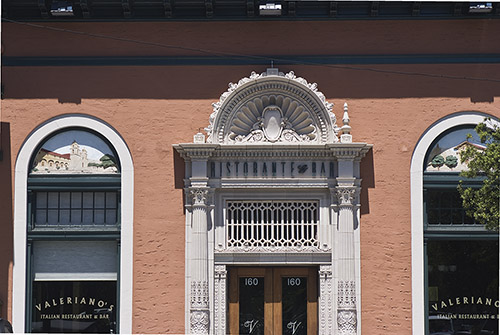
Ristorante @ISO 100
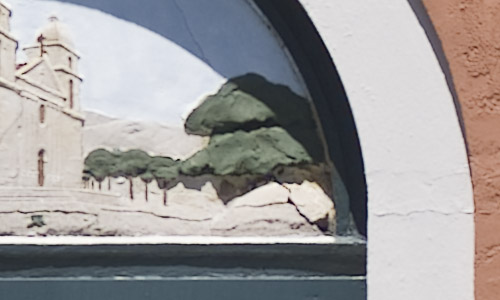
Crop @100% magnification
We used for this test our top AF-S 28-70mm
f/2.8. This is one of the best zooms we know. The resulting image is
slightly soft (even after some stronger sharpening with EasyS Plus). The colors and handling of the shadows are excellent. Overall we like the result very much.
You can download the original RAW and JPEG from here (>27MB).
Note: Remember that the service we provide is financed
by selling our ebooks and PS
tools.
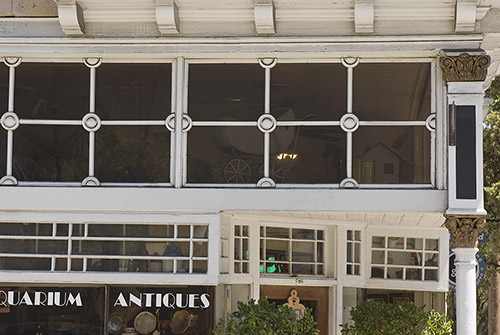
Antique store @ ISO 400
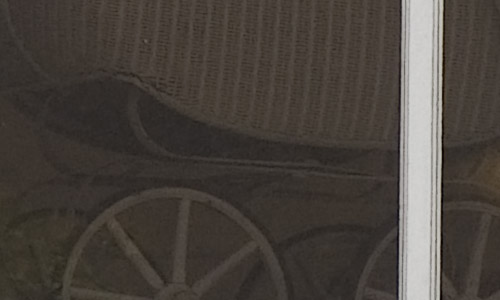
@ 100% magnification
Shadow noise at ISO 400 is very good.
ISO Test
We converted with Camera Raw 4.1 beta (luminance noise
removal to zero) and then sharpened with the same level of EasyS Plus (actually quite aggressively).
Note: Because of the bright blossoms of this tree the scene had a very high contrast. This is even hard to capture with the S5. Our goal is not to judge the full scene but the window crop. Because of the high contrast getting an optimal exposure for the window is difficult. We think these shots are in terms of the window slightly dark. This means that the ISO behavior maybe actually better than our images show.
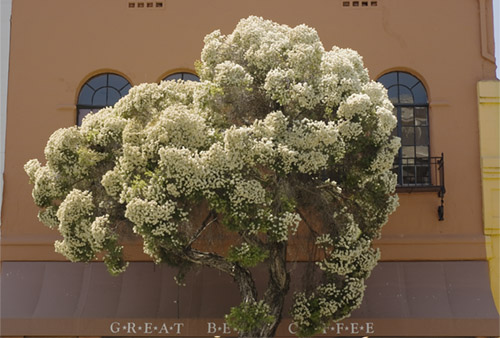
Bear Coffee Shop
Fuji S5 |
| |
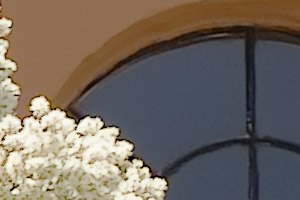
ISO 100 |
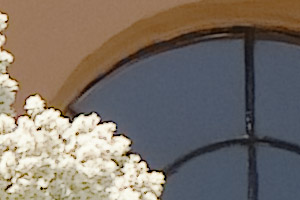 ISO
200 |
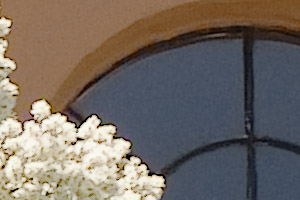
ISO 400 |
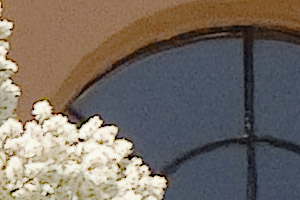
ISO 800 |
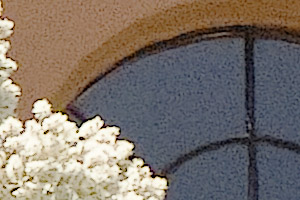
ISO 1600 |
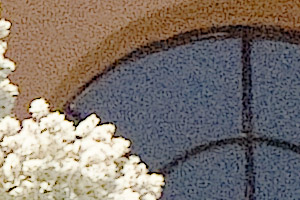
ISO 3200 |
Remember all these shots are with all luminance noise removal off in camera
and raw converter. Up to ISO 200 very smooth with virtually no noise.
ISO 400 still excellent,
ISO
800
very
good.
At
1600 some
grain
but
very
useable and if you need 3200 you still may risk it. For images at 1600-3200
we would try some noise removal tools and would not sharpen the shadow parts.
First conclusion
Overall we find the Fuji S5 a very exciting camera. The highlight extension paired with excellent noise characteristics raise the bar for image quality and shows that not only Megapixels matter.
Note: We have some AF hickup with our Nikon AF-S 28-70mm f/2.8 lens (it sometimes does not focus). We have no idea whether it is the body or the lens at that moment. It only happens if the lens is originally way out of focus. With some manual help all is fine.The lens is now over 6 years old. Our Nikon AF-S 70-200mm f/2.8 VR works just fine.
5/30/2007 Camera Raw 4.1 works now with Fuji S5
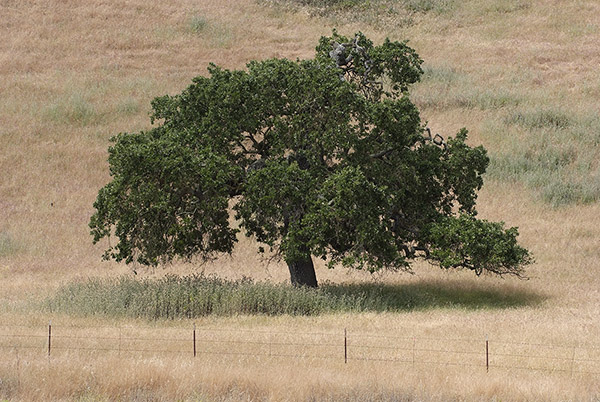
Fuji S5 with AF-S 70-200mm f/2.8 VR
Good news: the new Camera Raw 4.1 works with the S5. We looked over the last few days into a few different raw converters for the S5 and can say that Camera Raw 4.1 works quite well with the S5 (also 12MP mode). We will cover other raw options soon.
Note on the image above: The tonality of S5 images is just beautiful
5/31/2007 Storing S5 images as DNG files
If you use Camera RAW 4.1 or newer as you main RAW converter you can save quite a bit of disk space by converting the S5 RAW files to DNG:
- Fuji RAF RAW files: 24.1 MB
- Converted DNG file (lossless compressed): 12-15 MB
Too bad that neither Fuji Hyper Utility nor Silkypix could make use of the DNG files.
6/4/2007 Fuji S5 sample gallery
We are actually quite a bit excited to use the Fuji S5. It clearly may not have the absolute resolution of a Canon 5D but the higher dynamic range in the highlights pays off big time. We would say that we get a much higher rate of keepers if we photograph under more sunny light.
We hope the posted gallery shows that we are using the S5 for our real work and not just for testing. We plan to compare the Canon 5D and even the new Canon 1D Mk. III with the S5. Would we like to have more resolution with the S5? Of course! Would we want to lose the S5 dynamic range? No!!
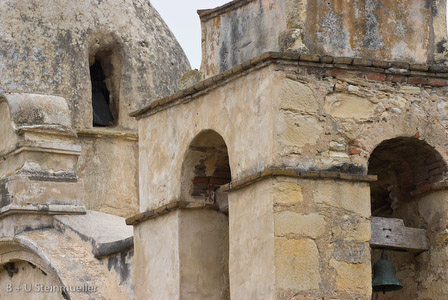
Gallery
7/6/2007 DPReview's Fuji S5 Review
DPReview clearly shows that the resolution of the S5 is no match for cameras like the Canon 5D or other top 10MP cameras. But in terms of dynamic range the S5 is in a league of its own. There are many situations where we take dynamic range over resolution. Too bad, but right now you cannot get both in one camera.
7/7/2007 S5 Sample Gallery #2
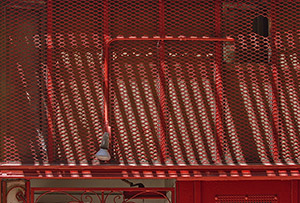
We are very happy with the images we can create from the Fuji S5. Yes, we know the resolution is not as good as a Canon 5D or Canon 1D Mark III. On the other side we have more keepers from the S5 than any other camera before. Why? It is all about the higher dynamic range this camera can produce. We take now pictures at light situations (strong sun light) we would not have risked in the past.
We also have to attribute the results to a revised image workflow (see below). In the end the S5 delivers beautiful images with very soft and rich highlights.
A few notes about our processing technique
- All images in this gallery are treated with the LightZone 3.x Relight tool (read our review here). LightZone Relight combines an extremely powerful Shadow/Highlight tool with a sophisticated detail enhancer.
- Lens distortions fixed with LensFix (use PTLens on Windows)
- Perspective corrections in Photoshop CS3
- Gallery created from Lightroom 1.1 using a template created by Matthew Campagna.
- To get the best detail from the Fuji S5 careful sharpening is the main challenge.
|